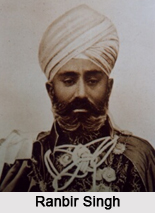 During British rule in India (which covers both the British East India Company rule and later the British Raj), the princely state of Jind was ruled by many people. Some had served the state as "Raja" and some had served it as "Raja i Rajgan" and "Maharaja" as well. Given below are the rulers of the princely state of Jind.
During British rule in India (which covers both the British East India Company rule and later the British Raj), the princely state of Jind was ruled by many people. Some had served the state as "Raja" and some had served it as "Raja i Rajgan" and "Maharaja" as well. Given below are the rulers of the princely state of Jind.
Gajpat Singh
Gajpat Singh was the first Raja of Jind from 1763 to 11th of November, 1789. He was granted the title of Raja under a royal decree by Mughal Emperor, Shah Alam II. He had seized a large tract of the country, including Jind and Safidori and made Jind his capital in 1766.
Bhag Singh
Bhag Singh was the Raja of Jind from 11th of November, 1789 to 16th of June, 1819. He is recorded in Indian history as a man of extraordinary vigor, intelligence and diplomatic astuteness. He was friendly with the British and accompanied Lord Lake to the River Beas in pursuit of Jaswant Rao Holkar.
Fateh Singh
Fateh Singh was the Raja of Jind from 16th of June 1819 to 3rd of February, 1822.
Sangat Singh
Sangat Singh was the Raja of Jind from 3rd February, 1822 to 4th of November, 1834.
Sarup Singh
Sarup Singh was the Raja of Jind from 8th of March, 1837 to 26th of January, 1864. Sarup Singh was loyal to the British during the Anglo-Sikh Wars and the Revolt of 1857. He was therefore rewarded with the grant of territories, Dadri in Haryana, thirteen villages near Sangrur, a house in Delhi, eleven gun salute, the right of adoption in case of failure of direct heirs and other concessions. Many reforms were introduced by him in his state based on the British model.
Raghubir Singh
Raghubir Singh was the Raja of Jind from 26th of January, 1864 to 24th of May, 1881 and the Raja i Rajgan from 24th of May, 1881 to 7th March, 1887. He was made a Knight Grand Commander of the Most Exalted Order of the Star of India and was appointed as a Councilor of the Empress.
Ranbir Singh
Ranbir Singh was the Raja i Rajgan of Jind from 7th of March, 1887 to 12th of December, 1911 and the Maharaja of Jind from 12th of December, 1911 to 15th of August, 1947.



















